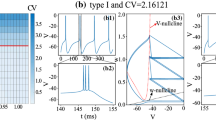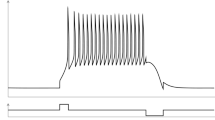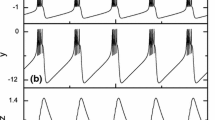Abstract
Rhythmic bursting activity, found in many biological systems, serves a variety of important functions. Such activity is composed of episodes, or bursts (the active phase, AP) that are separated by quiescent periods (the silent phase, SP). Here, we use mean field, firing rate models of excitatory neural network activity to study how AP and SP durations depend on two critical network parameters that control network connectivity and cellular excitability. In these models, the AP and SP correspond to the network's underlying bistability on a fast time scale due to rapid recurrent excitatory connectivity. Activity switches between the AP and SP because of two types of slow negative feedback: synaptic depression—which has a divisive effect on the network input/output function, or cellular adaptation—a subtractive effect on the input/output function. We show that if a model incorporates the divisive process (regardless of the presence of the subtractive process), then increasing cellular excitability will speed up the activity, mostly by decreasing the silent phase. Reciprocally, if the subtractive process is present, increasing the excitatory connectivity will slow down the activity, mostly by lengthening the active phase. We also show that the model incorporating both slow processes is less sensitive to parameter variations than the models with only one process. Finally, we note that these network models are formally analogous to a type of cellular pacemaker and thus similar results apply to these cellular pacemakers.
Similar content being viewed by others
References
Bertam R, Previte J, Sherman A, Kinard TA, Satin LS (2000) The phantom burster model for pancreatic β-cells. Biophys J 79: 2880–2892.
Borodinsky LN, Root CM, Cronin JA, Sann SB, Gu X, Spitzer NC (2004) Activity-dependent homeostatic specification of transmitter expression in embryonic neurons. Nature 429: 523–530.
Bracci E, Ballerini L, Nistri A (1996) Spontaneous bursts induced by pharmacological block of inhibition in lumbar motoneurons of the neonatal rat spinal cord. J Neurophysiol 75: 640–647.
Butera RJ, Rinzel J, Smith JC (1999) Models of respiratory rhythm generation in the pre-Bötzinger complex: I. Bursting pacemaker neurons. J Neurophysiol 82: 382–397.
Butts DA, Feller MB, Shatz CJ, Rokhsar DS (1999) Retinal waves are governed by collective network properties. J Neurosci 19: 3580–3593.
Compte A, Sanchez-Vives MV, McCormick DA, Wang X-J (2003) Cellular and network mechanisms of slow oscillatory activity (<1 Hz) and wave propagations in a cortical network model. J Neurophysiol 89: 2707–2725.
Coombes S, Bressloff PC (eds.) (2005) Bursting: The genesis of rhythm in the nervous system. World Scientific.
Ermentrout B (1998) Linearization of f-i curves by adaptation. Neural Comput 10: 1721–1729.
Ermentrout B (2002) Simulating, analyzing, and animating dynamical systems. SIAM.
Ermentrout G, Chow CC (2002) Modeling neural oscillations. Physiol and Behav 77: 629–633.
Friesen WO, Block GD (1984) What is a biological oscillator? Am J Physiol 246: R847–853.
Giugliano M, Darbon P, Arsiero M, Lüscher H-R, Streit J (2004) Single-neuron discharge properties and network activity in dissociated cultures of neocortex. J Neurophysiol 92: 977–996.
Gu X, Spitzer NC (1995) Distinct aspects of neuronal differentiation encoded by frequency of spontaneous Ca2+ transients. Nature 375: 784–787.
Hanson MG, Landmesser LT (2004) Normal patterns of spontaneous activity are required for correct motor axon guidance and the expression of specific guidance molecules. Neuron 43: 687–701.
Heeger DJ (1993) Modeling simple-cell direction selectivity with normalized, half-squared, linear operators. J Neurophysiol 70: 1885–1898.
Holt GR, Koch C (1997) Shunting inhibition does not have a divisive effect on firing rates. Neural Comput 9: 1001–1013.
Latham PE, Richmond BJ, Nelson PG, Nirenberg S (2000) Intrinsic dynamics in neuronal networks. I. Theory. J Neurophysiol 83: 808–827.
Marchetti C, Tabak J, Chub N, O'Donovan MJ, Rinzel J (2005) Modeling spontaneous activity in the developing spinal cord using activity-dependent variations of intracellular chloride. J Neurosci 25: 3601–3612.
Marder E, Calabrese R (1996) Principles of rhythmic motor pattern generation. Physiol Rev 76: 687–717.
Netoff TI, Clewley R, Arno S, Keck T, White JA (2004) Epilepsy in small-world networks. J Neurosci 24: 8075–8083.
O'Donovan MJ (1999) The origin of spontaneous activity in developing networks of the vertebrate nervous system. Curr Opin Neurobiol 9: 94–104.
Pena F, Parkis MA, Tryba AK, Ramirez J-M (2004) Differential contribution of pacemaker properties to the generation of respiratory rhythms during normoxia and hypoxia. Neuron 43: 105–117.
Pinto DJ, Brumberg JC, Simons DJ, Ermentrout GB (1996) A quantitative population model of whisker barrels: Re-examining the wilson-cowan equations. J Comput Neurosci 3: 247–264.
Rinzel J, Ermentrout GB (1998) Analysis of neural excitability and oscillations. In Methods in Neuronal Modeling. MIT Press.
Rinzel J (1985) Excitation dynamics: Insights from simplified membrane models. Fed Proc 44: 2944–2946.
Rozzo A, Ballerini L, Abbate G, Nistri A (2002) Experimental and modeling studies of novel bursts induced by blocking Na+ pump and synaptic inhibition in the rat spinal cord. J Neurophysiol 88: 676–691.
Sanchez-Vives MV, Nowak LG, McCormick DA (2000) Cellular mechanisms of long lasting adaptation in visual cortical neurons in vitro. J Neurosci 20: 4286–4299.
Skinner FK, Turrigiano GG, Marder E (1993) Frequency and burst duration in oscillating neurons and two-cell networks. Biol Cybern 69: 375–383.
Smolen P, Sherman A (1994) Phase independent resetting in relaxation and bursting oscillators. J theor Biol 169: 339–348.
Staley KJ, Longacher M, Bains JS, Yee A (1998) Presynaptic modulation of CA3 network activity. Nature Neurosci 1: 201–209.
Stellwagen D, Shatz CJ (2002) An instructive role for retinal waves in the development of retinogeniculate connectivity. Neuron 33: 357–367.
Tabak J, Latham PE (2003) Analysis of spontaneous bursting activity in random neural networks. Neuroreport 14: 1445–1449.
Tabak J, Rinzel J, O'Donovan MJ (2001) The role of activity-dependent network depression in the expression and self-regulation of spontaneous activity in the developing spinal cord. J Neurosci 21: 8966–8978.
Tabak J, Rinzel J (2005) Bursting in excitatory neural networks. In Coombes S, Bressloff, P (eds.) Bursting: The Genesis of Rhythm in the Nervous System, World Scientific, pp. 273–301.
Tabak J, Senn W, O'Donovan MJ, Rinzel J (2000) Modeling of spontaneous activity in the developing spinal cord using activity-dependent depression in an excitatory network. J Neurosci 20: 3041–3056.
Tsodyks M, Uziel A, Markram H (2000) Synchrony generation in recurrent networks with frequency-dependent synapses. J Neurosci 20: RC50.
Viemari J-C, Ramirez J-M (2004) Role of norepinephrine in respiratory rhythm generation. Soc Neurosci Abs 755.1.
Wiedemann UA, Lüthi A (2003) Timing of network synchronization by refractory mechanisms. J Neurophysiol 90: 3902–3911.
Wilson HR, Cowan JD (1972) Excitatory and inhibitory interactions in localized populations of model neurons. Biophys J 12: 1–24.
Wilson HR (2003) Computational evidence for a rivalry hierarchy in vision. Proc Natl Acad Sci 100: 14499–14503.
Yee AS, Longacher M, Staley KJ (2003) Convulsant and anticonvulsant effects on spontaneous CA3 population bursts. J Neurophysiol 89: 427–441.
Author information
Authors and Affiliations
Corresponding author
Additional information
Action Editor: Misha Tsodyks
Rights and permissions
About this article
Cite this article
Tabak, J., O'Donovan, M.J. & Rinzel, J. Differential control of active and silent phases in relaxation models of neuronal rhythms. J Comput Neurosci 21, 307–328 (2006). https://doi.org/10.1007/s10827-006-8862-7
Received:
Revised:
Accepted:
Published:
Issue Date:
DOI: https://doi.org/10.1007/s10827-006-8862-7




